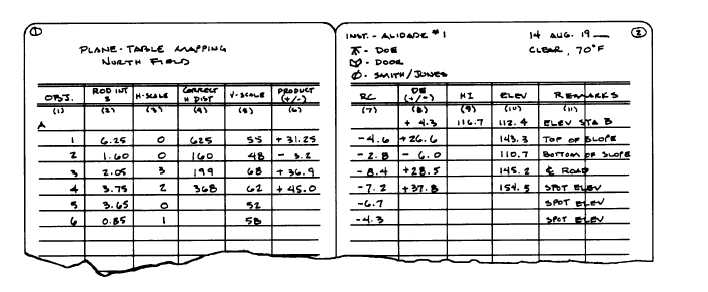6. Fewer points are required for the same precision
in locating contours (only 50 to 60 percent of the
number on a comparable transit-stadia survey are
required to locate contours with the same degree of
accuracy).
Disadvantages of the plane table method are as
follows:
1. The plane table and its plotting and drawing
accessories are more difficult to transport than
transit-stadia equipment.
2. Weather not bad enough to rule out transit-stadia
will make plane-table work impossible.
3. The use of the plane table is limited to relatively
level, open country. It is unsuitable for wooded country.
4. Control must be plotted in advance for precise
work on the plane table.
As mentioned above, keeping field notes is not
mandated for plane-table topographic work; however,
when notes are kept, they should appear as shown in
figure 9-8. An explanation of the columns shown in
these notes is as follows:
1. OBJ: Self-explanatory.
2. ROD INT (S): Rod or stadia interval.
3. H-SCALE: Reading from the Beaman arc
horizontal scale when the stadia interval was taken. (In
this example, the stadia arc we are using is a horizontal
scale subtraction type: vertical scale index = 50.)
4. CORRECT H DIST: Corrected horizontal
distance. This distance is computed as explained in
chapter 8 of this TRAMAN.
5. V-SCALE: Reading from the Beaman arc
vertical scale when the middle cross hair was sighted on
the rod and RC (column 7) was recorded. (Vertical scale
index = 50.)
6. PRODUCT *: Product difference; you
compute this by subtracting 50 from the V-scale
(column 5) and then multiplying this difference by the
stadia interval (column 2). Indicating the correct sign,
+ or -, is very important.
7. RC: Rod reading when the vertical scale was
read and the center cross hair was sighted on the rod.
The RC is always negative because it is considered a
foresight.
8. DE*: Algebraic sum of columns 6 and 7.
9. HI: Height of instrument obtained by adding
backsight reading to existing elevation.
10. ELEV: Computed elevation; algebraic sum of
columns 8 and 9.
11. REMARKS: Self-explanatory.
When other types of alidades are used, you may
find it necessary or advantageous to alter the format
of your field notes. Remember, too, that before you
use any instrument, including the alidade, you should
always read and fully understand the operating
instructions for the instrument.
Figure 9-8.-Plane-table notes.
9-7

